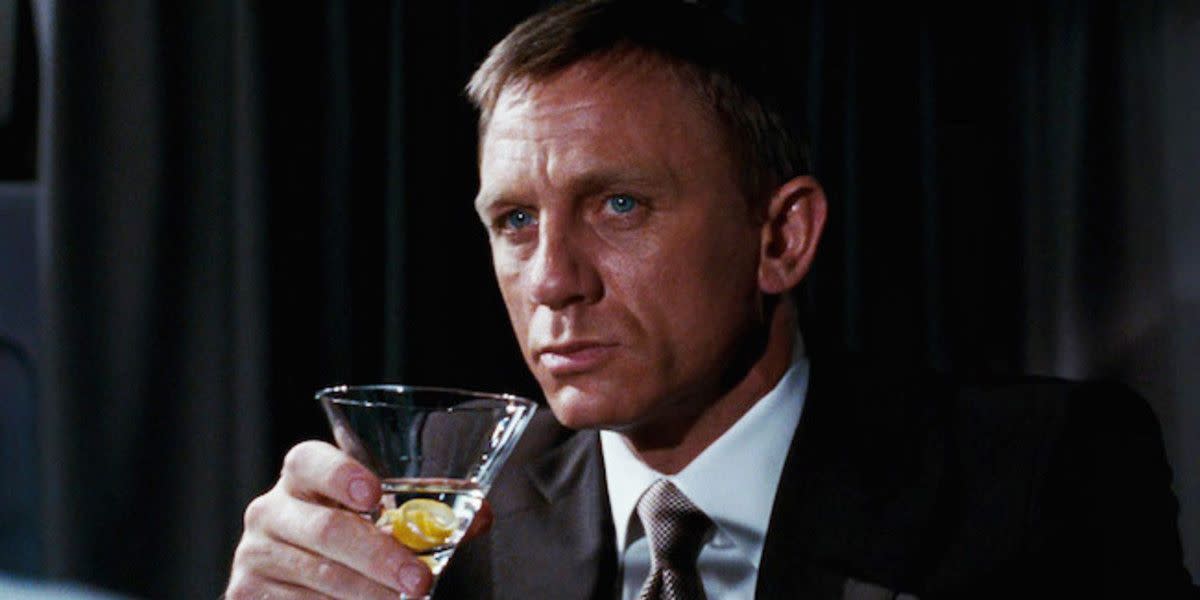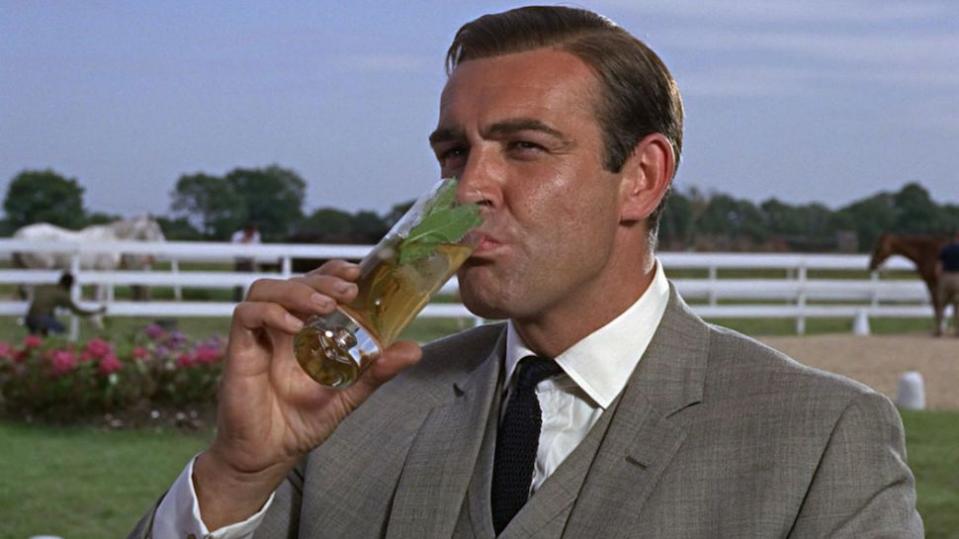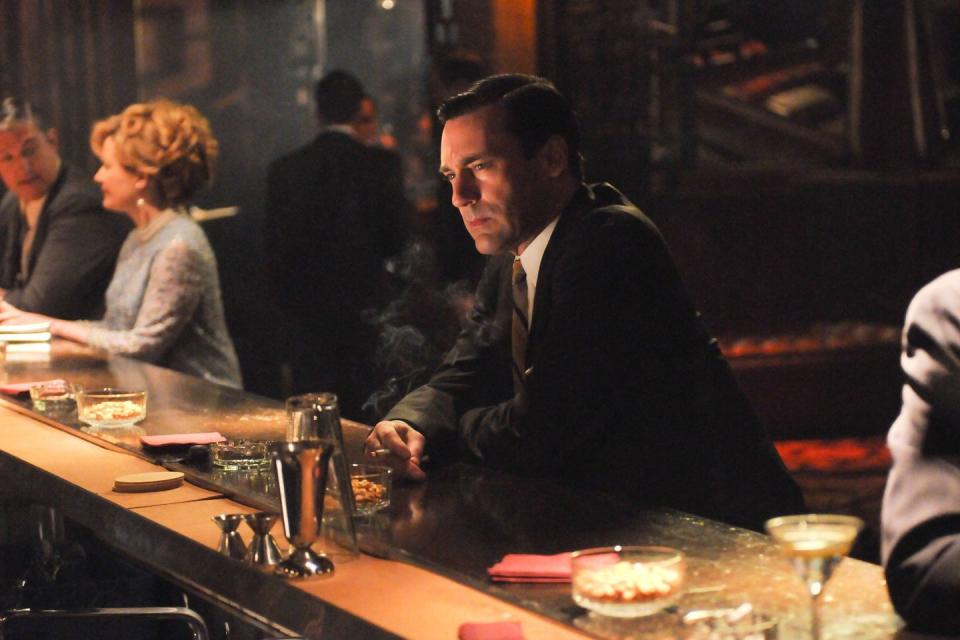The 10 Least Fattening Ways to Get Drunk

We hate to break it to you, but the calories in booze count. According to Alcohol Aware the humble pint contains as many of them as a large slice of pepperoni pizza. But that doesn't mean you have to quit booze completely if you want to lose weight. You just need to learn the difference between low-calorie alcohols and the stuff that goes straight to your beer belly.
Since the pubs have finally reopened things have got harder, sure. Over the summer the sun was shining and the ‘fancy a pint?’ texts flowed in with alarming regularity. Now it's autumn, the absolute prime time for bouncing into a pub for an impromptu bev as the nights draw in. It's hard. It is difficult.
If you want to move forward in a health-conscious way, then you need a plan; an approach that gives you full control over what you’re drinking, without robbing you of any of the fun or spontaneity that we've been jonesing for since March 2020.
The key is to be careful about what you're drinking. Cocktails often have the highest level of calories because of the sugary goodness that make them taste so delicious – a Manhattan has around 160 calories per drink and a Cosmopolitan around 200 calories per drink.
Your favourite beer isn't far behind either, with an average of 149 calories per pint. Don't forget also that when we drink our blood sugar levels struggle to stay balanced so in addition to the booze you'll probably want to devour something nasty on the way home. And this is on top of the calories you consume for the same reason whilst hungover. Life is hard.
But fret not! You can still enjoy a drink (or six) without consuming the equivalent of 14 Krispy Kreme doughnuts. Here are eight easy ways to enjoy yourself.

High alcohol / low sugar cocktails
Feel like treating yourself but don't want to blow the six-pack plan? Not all cocktails are created equal. Many of the concoctions you get served up in bars are basically desserts, packed with sugars and calories. (And they're usually delicious for it.)
Get to know the ones which are either short and strong so have a high percentage of alcohol with few sugary additions or those which you can substitute the sugar added for lower calorie options.
A mojito without sugar or sugar syrup - just soda, lime, mint and rum - is better for you. Other classics of the low-fat genre include:
Martini (vodka/gin, vermouth, lemon peel)
Negroni (Gin, vermouth, Campari, slice of orange)
Old Fashioned (Whiskey/bourbon, Angosturan bitters, orange slice)
Bloody Mary (Vodka, tomato juice, lemon juice, splashes of Worcestershire sauce and smoked Tabasco, celery stick)
But to be honest, there are loads of great options. Vodka, soda and lemon for example, and even kombucha with vodka (although it might be a stretch to refer to any of those as cocktails. More on low-fat mixers further down the page.)
With the above, ensure that you’re pulling them together yourself. Shop-bought cocktail mixes, even supposedly healthy ones, are often laced with a completely unnecessary sugars and sweeteners. They usually don’t taste as nice, either.
If you really want to get granular, you can lessen your calorie intake by choosing the right spirit brand. The less the alcohol percentage, the less calories appear in the drink, so a bottle of 80 proof vodka (40% alcohol) has 64 calories per 1oz, while a bottle of 100-proof (50%) arrives at 82 calories per 1oz.
Just make sure you eat something first.
It goes without saying that the internet is full of low-fat cocktail recipes, but BBC Good Food is always a brilliant resource for simple, affordable options.
Get into hard seltzers
Yes, the name 'hard seltzer' feels like quite an optimistic repositioning of 'alcohol plus fizzy water'. But they're among the lowest calorie alcoholic drinks you can find. White Claw, the taste sensation that swept the American nation a couple of years ago, clocks in at 95 calories per 330ml and the British-made High Water is 98 calories a can. That's about the same as a single shot of vodka.
Dig deeper and you can find lower calorie counts: Two Days, for instance, is only 65 calories a can and Served's cans are down to 57. Generally speaking it's the amount of sugar which makes the difference here, though compared to beer they also pack fewer carbs.
Does White Claw actually taste nice? Debatable. Very, very debatable. Would you want to have five of them? Again, very, very debatable. But then again, one of the implicit benefits of switching to hard seltzers is the built-in portion control. By the end of an afternoon session in the pub, you could easily have put away a few litres of beer or cider. Hard seltzers slow you down a little more, and chunk things up into smaller units.
That in turn makes it easier to keep tabs on how much you actually want to drink. How many times have you got distracted chatting and turned around to see someone put down a drink in front of you which, really, you know you don't want, but which you now feel obliged to drink? Then, before you know it, you're locked into another round and you're on a one-way trip to a late night mystery wrap and stinker of a next day.
They've yet to catch on here in the way they have stateside, which might be down to our general suspicion of any alcohol colder than room temperature. But in a straight shoot-out, you're not likely to find many lower calorie drinks around.
Eat a sizeable meal before you go out
We know this sounds slightly counter-productive from a weight loss perspective, but hear us out. How many times have you picked up a light bite on your way to the pub, to “line your stomach”, only to grow ravenously hungry over the course of the night as the hours pass and the drinks go down? You’re not going to order that exorbitantly-priced salad on the menu – your beer brain will simply not allow you to even consider it, and your body needs something more substantial anyway. It’s just not healthy to stave off hunger or drink on an empty stomach! Even if you do manage to resist ordering that burger/Sunday roast/sharing platter of nachos, you’re only kicking the can down the road towards the kebab shop, where you’ll soon be jabbing at a big styrofaom box of meat and chips.
There are plenty of reasons why drinking alcohol makes you hungry, from the rise and fall of blood sugar levels to the effects of ethanol on brain chemistry, but the crucial thing to remember is that you should not be denying your body the energy and nutrients that it so sorely needs. If possible, you shouldn’t set out on a night of drinking without a healthy and sizeable meal in your belly, packed with protein, fibre and healthy fats. If you do decide to order food at the bar, then don’t opt for salty snacks that will compel you drink more. It goes without saying that the more alcohol you take in, the more your inhibitions relax, and the more likely it is that you’ll eventually order the most extravagant item on the menu. If you need to bring healthy snacks along, then do so. But whatever it is you choose to do, the important part is to listen to your body.
Practise mindful drinking – and drink some water
Why is it that we’re able to down pint after pint of beer over a short period of time, when the prospect of doing so with any other drink feels weird and slightly nauseating? Well, it’s because alcohol is a diuretic, and stronger booze can have a dehydrating effect on your body. It’s not just FOMO keeping you out for one more drink and the promise of a weekend-ruining hangover – it’s science, too. This is especially the case if you’re drinking on an empty stomach, and alcohol takes a while to metabolise, so you’re not feeling the full impact of your pint immediately.
But there’s a solution. Mindful drinking is the practice of taking more time over your drink – sipping and savouring the complexities of it, rather than chucking it down your throat in an unnecessary rush. Think of it as a much more enjoyable version of the raisin technique espoused by wellness practitioners the world over. Your attitude to drinking will soon change – not just the amount of unit you get through in a night, but also your order at the bar. You’d be hard pressed to produce tasting notes on a pint of Fosters, so you’ll naturally gravitate towards drinks you genuinely enjoy. It’s not always easy, and it takes discipline, but it’s worthwhile.
Regularly alternate between pints of beer and water, too. (Ditto water with wine, cocktails etc). It will naturally limit the amount of booze you drink, keep you hydrated and protect you against the most hellish of hangovers (though it won’t stop them altogether, of course). Bars, pubs and restaurants are legally obligated to provide free drinking water to customers, though many people still feel awkward asking for it come Friday night. Get a beer and a glass of water at the same time, and you’re set.
Get out of the round system
You arrive at the pub to meet your friends, and someone immediately asks you what you want from the bar. You don’t want to complicate their order with an obscure light beer or expensive cocktail, so you just go along with the crowd. A pint of non-specific lager, please. And now you’re trapped in a high calorie round-cycle, trying to keep pace with everyone out of politeness and buying endless drinks that you never even wanted in the first place.
Ducking out of the round system is not the cardinal sin you think it is. It’s annoying having to go up to the bar every time, of course, but it’s worth it for the sake of exercising full control over your evening. Free yourself from that sense of obligation and just be honest about what you’re trying to achieve. If your friends are in any way decent, they’ll pay it no mind. If they’re not, they’ll soon be too drunk to pay attention anyway.
It should also be said that the advent of drink-ordering apps at pubs has made going your own way that much easier. You no longer have to join the huddled masses at the bar, solo, vying for a member of staff’s attention while the rest of your friends sup away in the background. Just insist from the very start that you want to order your own drinks, and do so with the minimum of fuss.
Once you’ve done that, try to stay aware about how fast you’re drinking. Follow the mindfulness tips above. Savour the taste with greater intervals between sips. You’ll end up drinking less and enjoying it more.
Take your spirits with low-sugar mixers
Unsurprisingly, straight spirits contain the least amount of calories as are nearly entirely ethanol without added sugar. Vodka is the alcohol with the lowest calories, at around 100 calories per shot (that's a 50 ml double-measure). Whisky is slightly more, at roughly 110 calories a shot. Gin and tequila are also 110 calories a shot. More sugary spirits, like sambuca, come in around 160 calories a shot (another reason to avoid them, besides the taste). That said, those calorie values are for the neat spirit – you need to ensure you don't mix your spirits with high-sugar mixers like Coke, Red Bull or lemonade, which you can get through at a rate on a night out without realising you're drinking hundreds of calories.
If you can't face endless shots of vodka then substitute your soft drink mixer with soda water or diet tonic which have very little sugar. Even water if you're feeling particularly bulgy post-dinner.
Embrace Prosecco
Prosecco is around 70 calories per 100ml glass, compared to its more glamorous cousin Champagne, which comes in at roughly 95 calories per glass (it's less expensive, too). Prosecco or champagne cocktails usually mask the sharpness of the sparkling wine with sugar, so avoid these and just drink the bubbly stuff on its own.
It’s an especially good choice if you somehow find yourself at one of those bottomless boozy brunches (though if you’re trying to move forward in a more health-conscious way, the entire concept is far from ideal, obviously). While limitless pints might seem like the more appealing option, plastic flagons of beer will do absolutely no favours to your waistline.
Although, really, when we recommend Prosecco, we're not talking about the kind of cheap and not-so-cheerful bottle that you'd get included with an Oceana birthday table booking. Plenty of independent luxury booze brands, including Fiol Prosecco, are working hard to improve the reputation of the long-lamented drink. So give it a go.
Avoid sweet wines
Wine varies depending on the sweetness of the grape you choose, but a glass of red or white wine ranges on average from 84 to 90 calories. Dry wines contain minimal sugar and commonly have less than one gram of sugar per ounce. Comparatively, sweeter wines can be in excess of 2g per ounce, which will make a difference if you're picking a bottle. Or three. Dry red grapes include Pinot Noir, Merlot and Cabernet Sauvignon. Dry whites include Pinot Blanc, Sauvignon Blanc and Pinot Grigio.
If you're really committing to the new year's diet, then there are plenty of low-calories options, too. Non-alcoholic and light wines, which generally come in at 0.5% ABV per glass, are improving in quality and are widely available from supermarkets (although you might have a harder time at restaurants).

Swallow your pride and buy light beer
If you can't resist a cheeky pint (you #lad) then light beer is on average around 100 calories per can. This retains some of that flavour whilst saving about 50 calories compared to regular beer. However, a lot of diet beer also cuts out the alcohol meaning you need to drink twice the amount the get the same buzz - a fairly pointless idea. Check the alcohol percentage on diet beers don't drop off dramatically or you may end up consuming more calories by drinking more quantities. There are plenty of brilliant craft options, but you're more likely to find a Heineken Light (3.3%. 99 calories) or Coors Light (4.2%, 116 calories) in pubs and bars. If you can't bring yourself to order a diet beer, Guinness is only 126 calories – slightly less than other beers which are usually around 150. Food for thought.
That's not to say you shouldn't turn to 0% beers if you're just after the taste without any of the trouble. When it comes to varieties that are widely available in pubs, we'd opt for BrewDog's Nanny State (0.5%) or Heineken 0.0. There's been a rise in the amount of alcohol-free bars in the capital, too, but they mostly trade in high-sugar mocktails. In fact, the sheer weight of demand for low-and-no alcohol alternatives amongst younger drinkers – according to a KAM Media report, 47 per cent of people bought one in 2020 – has driven many pubs to include low-alcohol beer as a draught option on their menu. We’ve rounded up some of the best NOLO drinks consisting of an ABV of 0.5 per cent or less) here, featuring beers, wines and spirits.
Stay disciplined
In other words, just drink less of the same alcohol of your choice. Sounds simple, but we all know how our desire for booze can snowball with each fresh, thirsty-making glass.
If the aforementioned mindful drinking approach doesn’t work for you, then draw up a strict drinking plan for the week ahead – what you’ll be drinking, in what quantity and on what day. Don’t let one glass of wine in front of the TV turn into two, and make sure your stick solidly to any routine you set out.
A 2018 study found that there’s no safe level of alcohol consumption. While that sounds scary, the real lesson to be taken from it is that moderation is key; drink consciously, and stay in control.
Discipline is the name of the game, but you can also make things easier on yourself. Don’t overstock your fridge and cupboards with unnecessary booze, as it will only prove to be a temptation. Instead, perhaps stock up on a weekly basis, only buying the amount written out in your schedule. It may seem like an extreme or overzealous approach to take, but you’ll only need it until you’ve carved out a healthier routine for yourself. Alternatively, an alcohol diary will help you better understand your drinking diet, and identify any unhealthy patterns.
The most important thing of all, of course, is to have a healthy attitude towards alcohol consumption. Drinking less alcohol is not only beneficial to your waistline, but also your general health, sleep quality and state-of-mind. Your bank account will thank you, too. Taking a break from booze isn’t just for Sober October – everyone could do with a break every now and again. Whether it’s refreshing stretches of alcohol-free days or whole months on the wagon, everyone deserves a reprieve from hangovers. The NHS has tips on cutting down alcohol intake, which you can find here, and there are plenty of other invaluable resources online.
You Might Also Like

 Yahoo Movies
Yahoo Movies 
